When working with statistical data in Excel, one of the fundamental calculations I often perform is the sum of squares. This measure helps analyze variability in datasets, making it useful for regression analysis, variance calculations, and other statistical applications. In this article, I’ll walk you through the steps to calculate the sum of squares in Excel, whether manually or using built-in functions.
Key Takeaways:
- The sum of squares measures data variability, making it essential for statistical analysis in Excel.
- It can be calculated manually by squaring deviations from the mean or using the SUMSQ function for efficiency.
- The SUMXMY2 function computes the sum of squared differences between two datasets, aiding in comparative analysis.
- Avoid common errors by using absolute references, verifying data ranges, and updating formulas as needed.
- The sum of squares underpins key statistical methods, such as variance, standard deviation, and regression analysis.
Navigating Excel’s Mathematical Terrain
Understanding the Concept of the Sum of Squares
The concept of the sum of squares is like the secret sauce in statistical recipes—it makes the flavors of data come to life. Imagine we have an array of numbers, and we need to measure how spread out they are from their average. I approach it by subtracting the mean from each number, squaring those differences, and then adding them all up. This creates a comprehensive single value representing the variability within the data.
The Relevance of Sum of Squares in Excel
In my experience with Excel, the relevance of the sum of squares cannot be overstated, especially when it comes to the realm of data analysis. It underpins many statistical functions, from variance and standard deviation calculations to regression analysis. By mastering the sum of squares, I gained a formidable tool for quantifying the spread in a dataset, providing a foundation for making informed decisions based on solid numerical evidence.
Understanding this concept enhances my work with Excel, allowing me to conduct more nuanced and precise analyses.
Step-by-Step Guide to Calculate the Sum of Squares in Excel
Manual Calculation Using Formulas
To calculate the sum of squares in Excel, follow these steps:
STEP 1: List the values in column A.
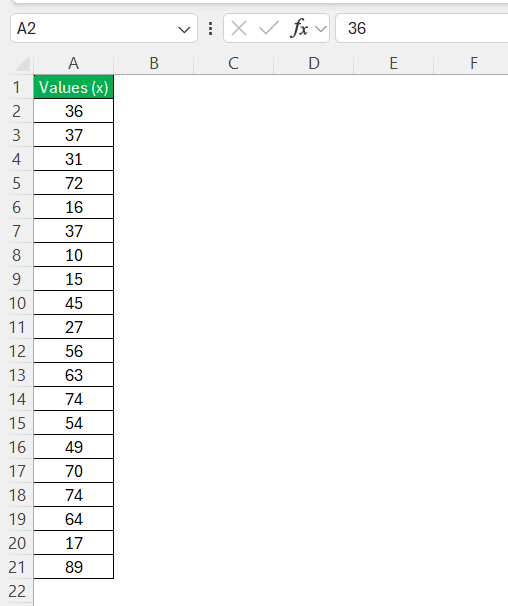
STEP 2: In Column B, use the formula below to square the values.
=A2^2
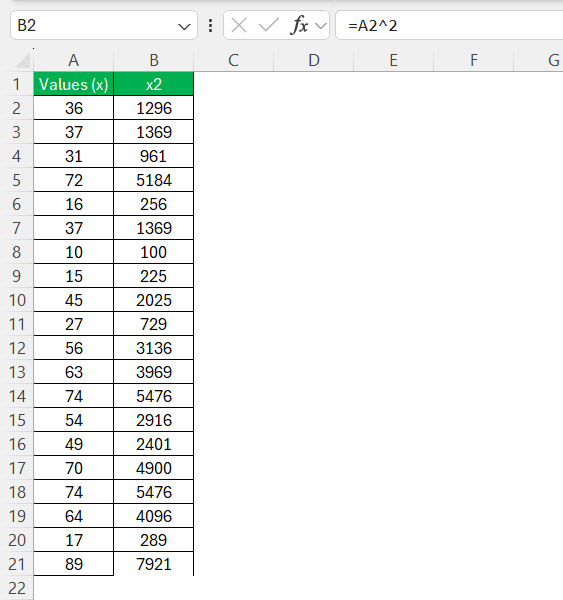
STEP 3: Finally, sum all the squared values using =SUM(B2:B21).
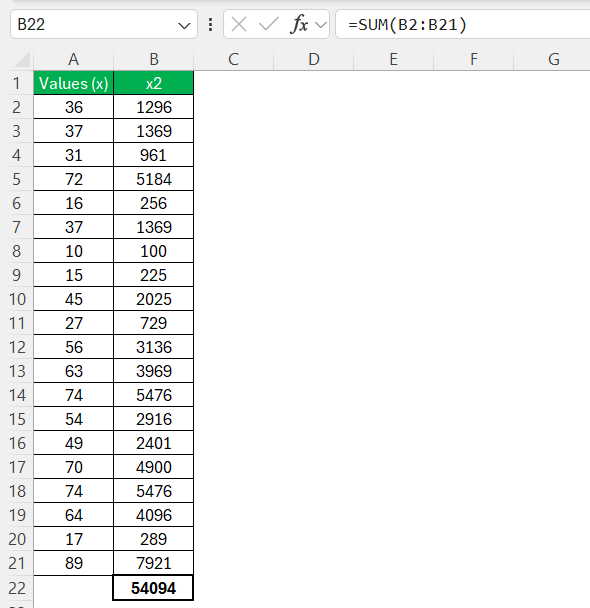
SUMSQ Function: A Data Pro’s Best Friend
For anyone who regularly juggles large datasets, the SUMSQ function in Excel becomes an indispensable ally. It’s beautifully straightforward: I simply feed it a range, array, or individual numbers, and it quietly calculates the sum of squares for me. What I appreciate most is that it accepts up to 255 arguments, making it robust for complex analyses. It eliminates the need to square each number individually before summing them, meaning I can skip several tedious steps without compromising accuracy.
To illustrate, I’d use =SUMSQ(A2:A21) to get the sum of squares for numbers in cells A1 through A10.
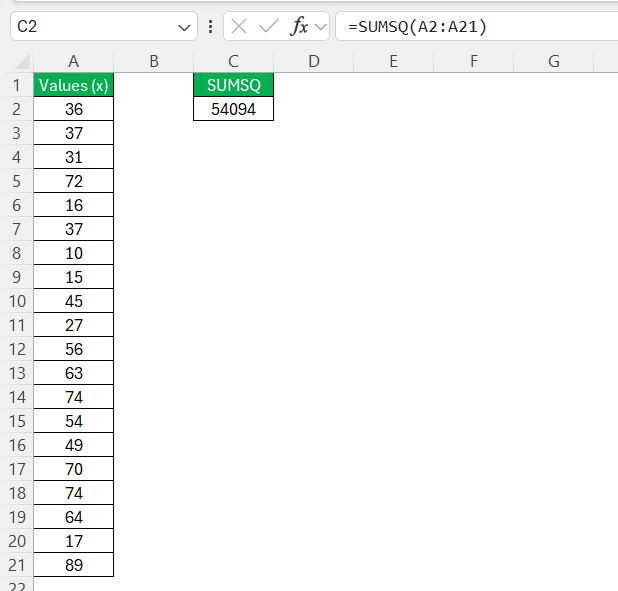
This expedient trick allows me to concentrate on interpreting my results, rather than getting bogged down in the calculation logistics. For the data professionals among us, it promises swift and reliable processing—a true Excel treasure.
SUMXMY2 function
The SUMXMY2 function in Excel calculates the sum of squares of differences between two arrays of numbers. This means it first finds the difference between corresponding values in two arrays, squares each difference, and then sums up the squared values.
Syntax:
SUMXMY2(array1, array2)
Each value in array1 is subtracted from the corresponding value in array2, squared, and then summed.
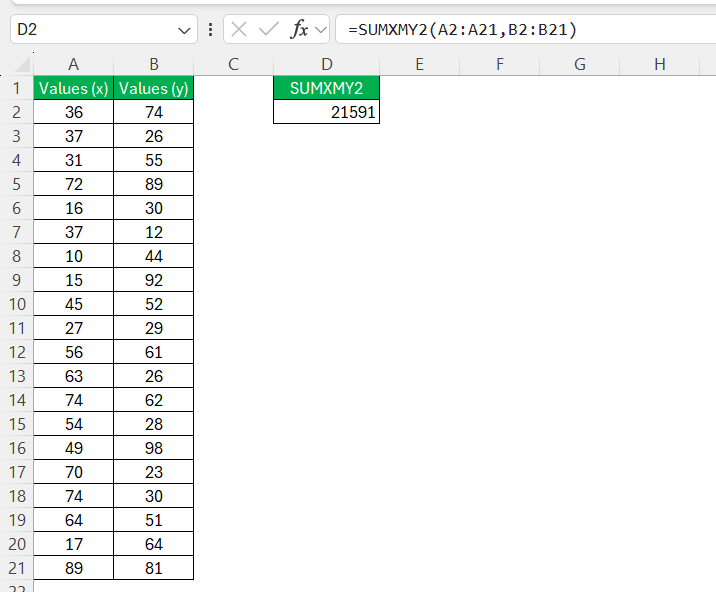
Tips & Tricks
Combating Common Errors When Working with Sum of Squares
While calculating the sum of squares may seem straightforward, it’s easy to fall prey to certain pitfalls that can skew my results. To combat these errors, I’ve developed a checklist based on the lessons learned along the way:
- Ensure fixed references with absolute cell references when necessary (e.g., $A$1) to prevent unwanted changes when copying formulas.
- Double-check data ranges to include the correct cells, as missing or extra cells can lead to inaccurate sums.
- Update formulas to reflect any changes in my dataset to maintain the integrity of my calculations.
- Embrace simplicity to avoid overcomplicating the process. Complex formulas can often be simplified, reducing the chance for error and increasing efficiency.
By incorporating these strategies into my workflow, I safeguard my calculations against common errors, striving for accuracy and reliability in every sum of squares computation I undertake in Excel.
By being vigilant and methodical in my approach, I fend off these typical mistakes and strengthen my data analysis with Excel, ensuring my sum of squares calculations remain error-free and trustworthy.
FAQ: Sum of Squares Finishing Touches
What is the formula for the sum of squares?
The formula for the sum of squares in Excel can be as simple as using the =SUMSQ() function, where I input the numbers or cells I need to sum. If calculating manually, it involves squaring each value, then summing these squares, which looks like =SUM((A1-AVERAGE(range))^2, (A2-AVERAGE(range))^2,...) for individual values in a range. Both methods lead me to the same quantitative destination—the total sum of the squared deviations.
What are the most common uses of Sum of Squares in Excel?
Sum of squares in Excel is most commonly used for statistical and data analysis purposes. I rely on it primarily to calculate variance and standard deviation, which are vital for understanding data spread. Additionally, it’s instrumental in regression analysis, where it helps me determine how well my independent variables explain the variation in the dependent variable, and in ANOVA (Analysis of Variance) tests, to compare different datasets and check if there are any statistically significant differences between them.
How do I apply conditions when calculating Sum of Squares?
To apply conditions when calculating the sum of squares, I use the SUMIFS function within an array formula or combine it with the SUMSQ function, to square and sum values that meet specific criteria. For instance, =SUM((B1:B10 * (A1:A10="North"))^2) calculates the sum of squares for sales in the “North” region. This tailors my sum of squares computation to focus on subsets of data based on defined conditions.
Why is the sum of squares so important?
The sum of squares is crucial as it serves as a cornerstone for various statistical methods, including variance and regression analysis. By quantifying the variability of data, I gauge how well a statistical model fits the data and how much variation in a dataset is due to the model versus random chance. This understanding allows for data-driven decisions, making the sum of squares a vital tool for analyzing trends, evaluating performance, and testing hypotheses.
How to use sumsq in Excel?
Using SUMSQ in Excel is straightforward. I select the cell where I want the result, enter the function, and then specify the cells or numbers to square and add. For example, to calculate the sum of squares for cells A1 through A10, I’d type =SUMSQ(A1:A10) and press Enter. Excel performs the squaring and summing in one step, providing a quick and error-free way to get the sum of squares.
John Michaloudis is a former accountant and finance analyst at General Electric, a Microsoft MVP since 2020, an Amazon #1 bestselling author of 4 Microsoft Excel books and teacher of Microsoft Excel & Office over at his flagship MyExcelOnline Academy Online Course.







